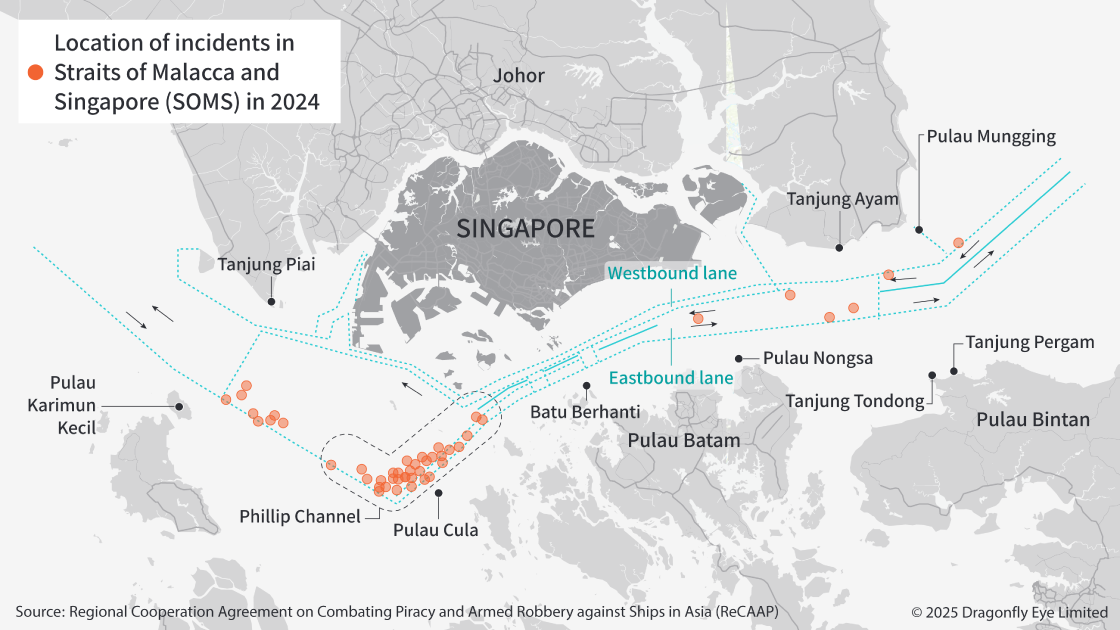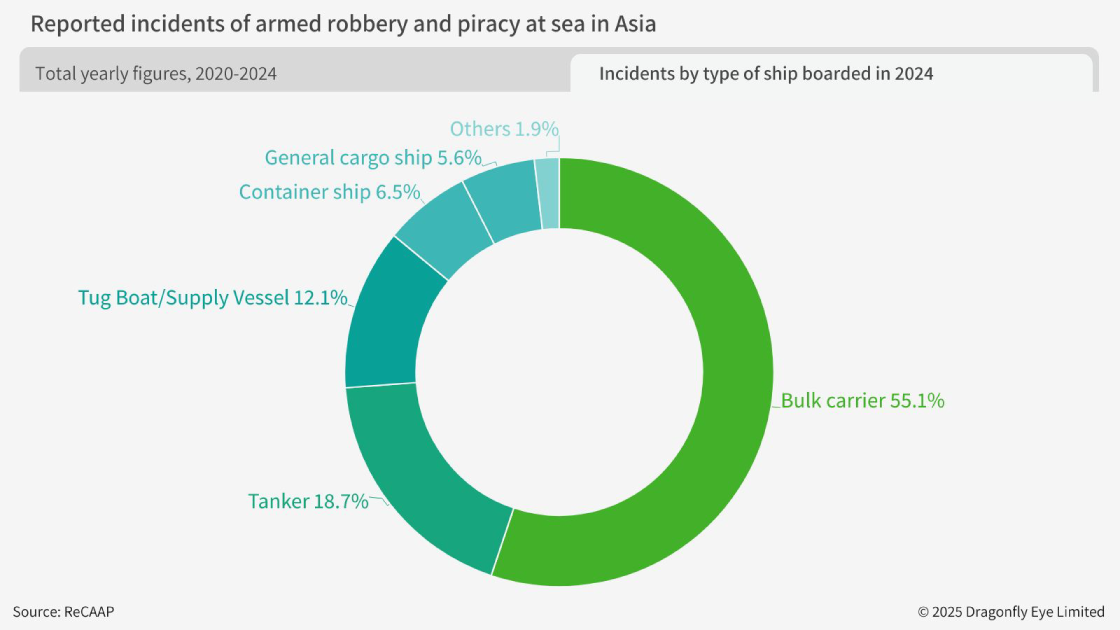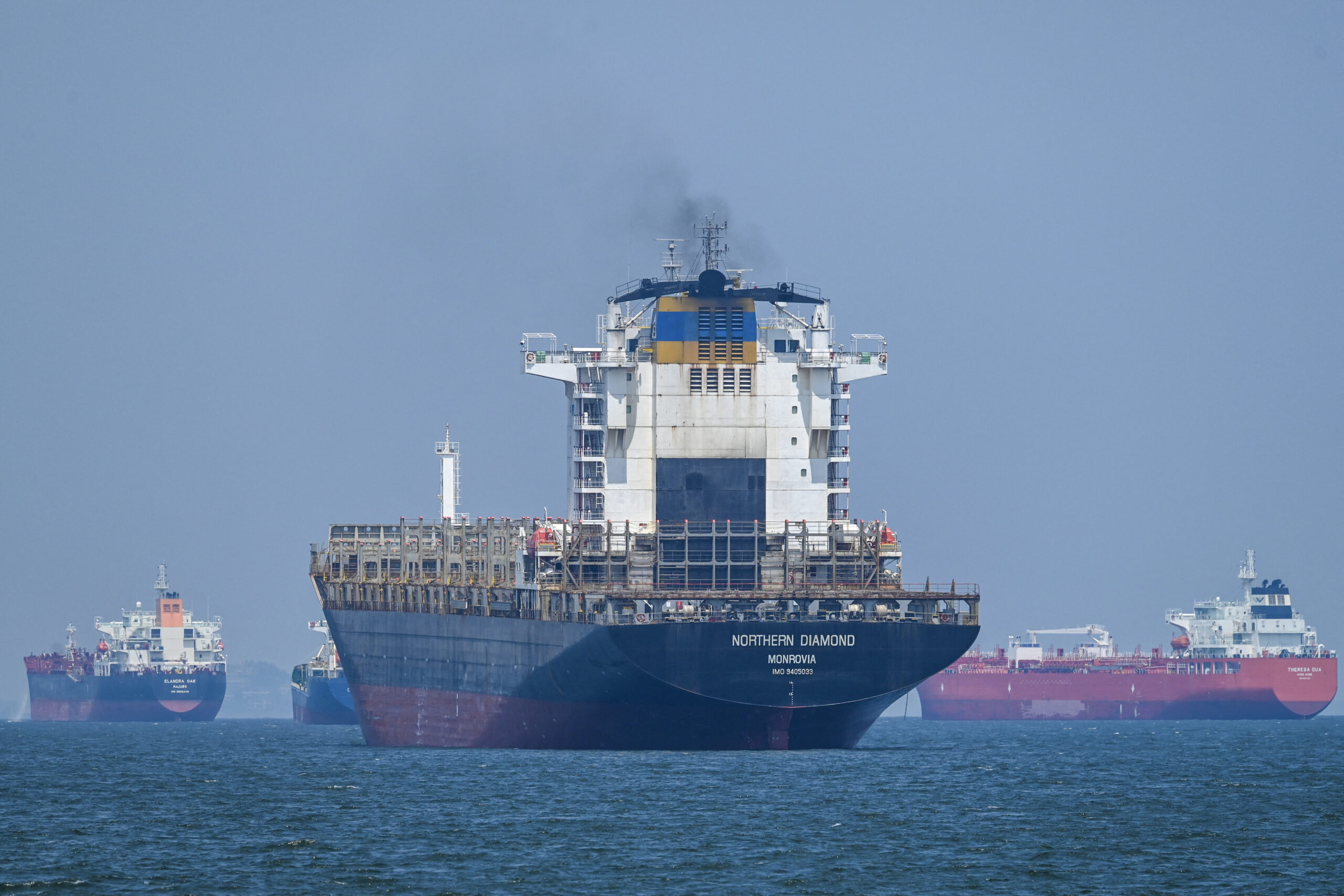Near-weekly armed robberies against shipping in the Straits of Malacca and Singapore are likely this year
This assessment was issued to clients of Dragonfly’s Security Intelligence & Analysis Service (SIAS) on 12 February 2025.
- There were 92 armed robberies in Southeast Asia in 2024, according to a regional piracy monitoring service
- The majority of incidents are likely to be non-violent and opportunistic, in our assessment
We anticipate there to be near-weekly armed robberies against commercial shipping in Southeast Asia this year. The number of such incidents has increased over the past two years compared with the 2021-2022 period. According to the data by regional monitoring service (ReCAAP), most incidents occur in the Straits of Malacca and Singapore (SOMS). These are usually non-violent, but assailants tend to carry bladed weapons such as knives. The authorities will probably struggle to address this; SOMS is one of the most congested shipping lanes in the world and has several overlapping jurisdictions. And perpetrators use fast boats to hide from law enforcement on surrounding islands.
Straits of Malacca and Singapore hotspot for seaborne theft
Armed robbery against ships has become more common in recent years. According to the data by ReCAAP, there were 187 such incidents over the past two years compared with 151 incidents during the two periods prior. This is despite a slight decrease in robberies in 2024 (92) compared with 2023 (95). Most incidents last year (52) took place in the eastbound traffic lane of the Singapore Strait near Indonesian territorial waters. Assailants appear to have been particularly active near Pulau Cula, where the number of incidents increased from 27 in 2023 to 45 in 2024.

The SOMS in particular is likely to remain a hotspot for robberies into 2025. In 2024, most incidents took place in SOMS (62) and Indonesia (22), with only a few reported cases in the Philippines (3), Vietnam (2) and the South China Sea (2). This is most likely because the narrow strait means that large commercial shipping vessels have to slow considerably to make a sharp turn. Consequently, this leads to congestion and slow-moving traffic, making vessels easier targets for robberies. And despite regional cooperation on law enforcement patrols, there are no new initiatives planned to combat this; the most recent crackdown on piracy in the area took place between 2014 and 2015.

Poor socioeconomic factors in Indonesia in particular, appear to be driving the consistently high number of these incidents in SOMS. Various organisations – such as the International Fusion Centre – have in recent years pointed towards economically insecure coastal communities that may perceive armed robbery as an option to supplement their incomes amid a lack of other viable opportunities.
In a sign of this, most maritime thefts in recent years seem to be motivated to meet personal financial needs. Perpetrators usually steal spare engine parts and personal belongings, most likely because such items can be easily and quickly moved and sold on the black market. There have been no publicly reported cases of crew abductions, attempts to stop ships underway, or kidnap for ransom in 2024 across the region. And the authorities have not pointed towards any links between these assailants and militant groups in the wider region either.
The majority of robberies are small-scale and largely non-violent
We assess that most robberies are likely to be opportunistic. Based on reported ReCaap data, perpetrators do not appear to be part of any large organised criminal group and usually number around five or six people at a time. And although assailants are reportedly armed with knives and machetes, victims were physically assaulted in only 3% of reported incidents in 2024. Serious injuries are rare and when they do occur, they usually prompt a crackdown by law enforcement. Two assailants stabbed a member of a ship crew during a robbery in mid-December 2024.
Perpetrators in most cases seem to be trying to avoid detection and confrontation. The open-source reporting of such incidents suggests that they usually try to flee if they are spotted by the crew. And seemingly in an attempt to not be seen, most robberies occur at night. We have also seen no reports of assailants targeting commercial cruise ships in the region. Most of the reported incidents involve large slow-moving commercial vessels, such as bulk carriers and tankers.

Regional maritime security forces will probably struggle to completely stop these incidents. There is ongoing regional cooperation to prevent piracy and maritime robberies between Indonesia, Malaysia and Singapore. However, the perpetrators’ tactics make it difficult for the authorities to counter them; most are from local coastal communities in Indonesia and use small unregistered boats. This allows them to move at high speed and cross maritime borders while avoiding detection. But, as a result, we doubt that groups will be able to substantially scale up their operations.
Image: Ships parking at the southern anchorage along the Singapore Strait in Singapore, on 15 July 2024. Photo by Roslan Rahman/AFP via Getty Images.




